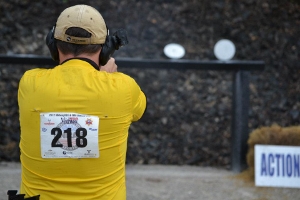One of my goals is to take one major pistol class every year. Usually I like to do it right before the shooting season kicks off in earnest, as it’s a decent way to tune up before the season and knock any rust off. Since I started this policy in 2011, I’ve taken the following three classes that I personally identify as shooting classes:
- Intensive Handgun Skills, InSights Training Center 2011
- Speed Kills/Get SOM, Todd Green 2012
- Get Better at Shooting, Matt Mink and Ben Stoeger 2013

Each class I’ve learned something new, something different that has improved my skills as a shooter. That’s the point of continued education – I want to keep learning. I have a lot of opportunities for continued learning at a few of the major matches I attend each year as well, because the availability of practice ranges at Bianchi Cup and Steel Challenge allows me to hang out with some of the best shooters in the world and learn things from them.
To enter the realm of opinions, I don’t think I’d recommend taking more than 2, 3 classes tops a year. If you’re taking loads and loads of training, it can dilute your opportunities to actually practice the skills you’re being taught in class, and the training class itself becomes a crutch for not practicing. “I took five classes this year, I don’t need to dry fire.” I’ve seen shooters, myself included fall into this trap when it comes to matches. It’s easy to justify not practicing when you’re shooting 3 or 4 matches a month for 8 months. Big training classes are a lot like major matches in that regard. You make a big commitment, shoot a lot of rounds in a compressed time frame, and then…go home. If you don’t practice what you learned, you won’t improve as much.
Breaking it down further, there are five key elements to progressing as a shooter. The first is Continued Learning. This means attending classes, reading books, watching videos, any way you can absorb information you might not already have. The second is Regular Practice. Take those techniques you’ve learned and practice them on the range, in dry fire, with mental rehearsals. Third is Pressure Testing. Take your techniques off the practice range and put them to use in simulated stressful environments. For must of us, this means shooting matches, so go find a local and shoot. The fourth element is Performance Review. This is where you look at the results of your pressure test, and prepare to make adjustments to your training cycle. Fifth and final is Rest and Repetition. After completing an entire cycle, take a day off, rest your mind and body, then repeat the process again. And again. If you keep these five elements in harmony, you’re guaranteed to progress as a shooter.
Very nice.